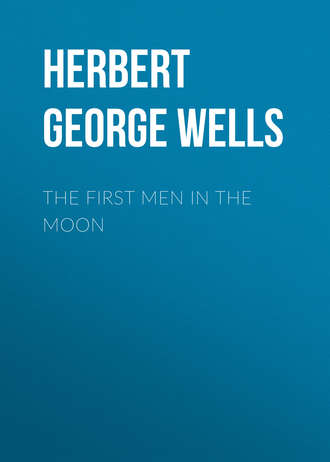 полная версия
полная версияThe First Men in the Moon
At first I thought the thing was an elaborate practical joke by some one who had seen the manuscript of my narrative. I answered Mr. Wendigee jestingly, but he replied in a manner that put such suspicion altogether aside, and in a state of inconceivable excitement I hurried from Algiers to the little observatory upon the Monte Rosa in which he was working. In the presence of his record and his appliances-and above all of the messages from Cavor that were coming to hand-my lingering doubts vanished. I decided at once to accept a proposal he made to me to remain with him, assisting him to take down the record from day to day, and endeavouring with him to send a message back to the moon. Cavor, we learnt, was not only alive, but free, in the midst of an almost inconceivable community of these ant-like beings, these ant-men, in the blue darkness of the lunar caves. He was lamed, it seemed, but otherwise in quite good health-in better health, he distinctly said, than he usually enjoyed on earth. He had had a fever, but it had left no bad effects. But curiously enough he seemed to be labouring under a conviction that I was either dead in the moon crater or lost in the deep of space.
His message began to be received by Mr. Wendigee when that gentleman was engaged in quite a different investigation. The reader will no doubt recall the little excitement that began the century, arising out an announcement by Mr. Nikola Tesla, the American electrical celebrity, that he had received a message from Mars. His announcement renewed attention to fact that had long been familiar to scientific people, namely: that from some unknown source in space, waves of electromagnetic disturbance, entirely similar those used by Signor Marconi for his wireless telegraphy, are constantly reaching the earth. Besides Tesla quite a number of other observers have been engaged in perfecting apparatus for receiving and recording these vibrations, though few would go so far to consider them actual messages from some extraterrestrial sender. Among that few, however, we must certainly count Mr. Wendigee. Ever since 1898 he had devoted himself almost entirely to this subject, and being a man of ample means he had erected an observatory on the flanks of Monte Rosa, in a position singularly adapted in every way for such observations.
My scientific attainments, I must admit, are not great, but so far as they enable me to judge, Mr. Wendigee's contrivances for detecting and recording any disturbances in the electromagnetic conditions of space are singularly original and ingenious. And by a happy combination of circumstances they were set up and in operation about two months before Cavor made his first attempt to call up the earth. Consequently we have fragments of his communication even from the beginning. Unhappily, they are only fragments, and the most momentous of all the things that he had to tell humanity-the instructions, that is, for the making of Cavorite, if, indeed, he ever transmitted them-have throbbed themselves away unrecorded into space. We never succeeded in getting a response back to Cavor. He was unable to tell, therefore, what we had received or what we had missed; nor, indeed, did he certainly know that any one on earth was really aware of his efforts to reach us. And the persistence he displayed in sending eighteen long descriptions of lunar affairs-as they would be if we had them complete-shows how much his mind must have turned back towards his native planet since he left it two years ago.
You can imagine how amazed Mr. Wendigee must have been when he discovered his record of electromagnetic disturbances interlaced by Cavor's straightforward English. Mr. Wendigee knew nothing of our wild journey moonward, and suddenly-this English out of the void!
It is well the reader should understand the conditions under which it would seem these messages were sent. Somewhere within the moon Cavor certainly had access for a time to a considerable amount of electrical apparatus, and it would seem he rigged up-perhaps furtively-a transmitting arrangement of the Marconi type. This he was able to operate at irregular intervals: sometimes for only half an hour or so, sometimes for three or four hours at a stretch. At these times he transmitted his earthward message, regardless of the fact that the relative position of the moon and points upon the earth's surface is constantly altering. As a consequence of this and of the necessary imperfections of our recording instruments his communication comes and goes in our records in an extremely fitful manner; it becomes blurred; it "fades out" in a mysterious and altogether exasperating way. And added to this is the fact that he was not an expert operator; he had partly forgotten, or never completely mastered, the code in general use, and as he became fatigued he dropped words and misspelt in a curious manner.
Altogether we have probably lost quite half of the communications he made, and much we have is damaged, broken, and partly effaced. In the abstract that follows the reader must be prepared therefore for a considerable amount of break, hiatus, and change of topic. Mr. Wendigee and I are collaborating in a complete and annotated edition of the Cavor record, which we hope to publish, together with a detailed account of the instruments employed, beginning with the first volume in January next. That will be the full and scientific report, of which this is only the popular transcript. But here we give at least sufficient to complete the story I have told, and to give the broad outlines of the state of that other world so near, so akin, and yet so dissimilar to our own.
Chapter 23. An Abstract of the Six Messages First Received from Mr. Cavor
The two earlier messages of Mr. Cavor may very well be reserved for that larger volume. They simply tell, with greater brevity and with a difference in several details that is interesting, but not of any vital importance, the bare facts of the making of the sphere and our departure from the world. Throughout, Cavor speaks of me as a man who is dead, but with a curious change of temper as he approaches our landing on the moon. "Poor Bedford," he says of me, and "this poor young man," and he blames himself for inducing a young man, "by no means well equipped for such adventures," to leave a planet "on which he was indisputably fitted to succeed" on so precarious a mission. I think he underrates the part my energy and practical capacity played in bringing about the realisation of his theoretical sphere. "We arrived," he says, with no more account of our passage through space than if we had made a journey of common occurrence in a railway train.
And then he becomes increasingly unfair to me. Unfair, indeed, to an extent I should not have expected in a man trained in the search for truth. Looking back over my previously written account of these things, I must insist that I have been altogether juster to Cavor than he has been to me. I have extenuated little and suppressed nothing. But his account is:-
"It speedily became apparent that the entire strangeness of our circumstances and surroundings-great loss of weight, attenuated but highly oxygenated air, consequent exaggeration of the results of muscular effort, rapid development of weird plants from obscure spores, lurid sky-was exciting my companion unduly. On the moon his character seemed to deteriorate. He became impulsive, rash, and quarrelsome. In a little while his folly in devouring some gigantic vesicles and his consequent intoxication led to our capture by the Selenites-before we had had the slightest opportunity of properly observing their ways…."
(He says, you observe, nothing of his own concession to these same "vesicles.")
And he goes on from that point to say that "We came to a difficult passage with them, and Bedford mistaking certain gestures of theirs"-pretty gestures they were! – "gave way to a panic violence. He ran amuck, killed three, and perforce I had to flee with him after the outrage. Subsequently we fought with a number who endeavoured to bar our way, and slew seven or eight more. It says much for the tolerance of these beings that on my recapture I was not instantly slain. We made our way to the exterior and separated in the crater of our arrival, to increase our chances of recovering our sphere. But presently I came upon a body of Selenites, led by two who were curiously different, even in form, from any of these we had seen hitherto, with larger heads and smaller bodies, and much more elaborately wrapped about. And after evading them for some time I fell into a crevasse, cut my head rather badly, and displaced my patella, and, finding crawling very painful, decided to surrender-if they would still permit me to do so. This they did, and, perceiving my helpless condition, carried me with them again into the moon. And of Bedford I have heard or seen nothing more, nor, so far as I can gather, any Selenite. Either the night overtook him in the crater, or else, which is more probable, he found the sphere, and, desiring to steal a march upon me, made off with it-only, I fear, to find it uncontrollable, and to meet a more lingering fate in outer space."
And with that Cavor dismisses me and goes on to more interesting topics. I dislike the idea of seeming to use my position as his editor to deflect his story in my own interest, but I am obliged to protest here against the turn he gives these occurrences. He said nothing about that gasping message on the blood-stained paper in which he told, or attempted to tell, a very different story. The dignified self-surrender is an altogether new view of the affair that has come to him, I must insist, since he began to feel secure among the lunar people; and as for the "stealing a march" conception, I am quite willing to let the reader decide between us on what he has before him. I know I am not a model man-I have made no pretence to be. But am I that?
However, that is the sum of my wrongs. From this point I can edit Cavor with an untroubled mind, for he mentions me no more.
It would seem the Selenites who had come upon him carried him to some point in the interior down "a great shaft" by means of what he describes as "a sort of balloon." We gather from the rather confused passage in which he describes this, and from a number of chance allusions and hints in other and subsequent messages, that this "great shaft" is one of an enormous system of artificial shafts that run, each from what is called a lunar "crater," downwards for very nearly a hundred miles towards the central portion of our satellite. These shafts communicate by transverse tunnels, they throw out abysmal caverns and expand into great globular places; the whole of the moon's substance for a hundred miles inward, indeed, is a mere sponge of rock. "Partly," says Cavor, "this sponginess is natural, but very largely it is due to the enormous industry of the Selenites in the past. The enormous circular mounds of the excavated rock and earth it is that form these great circles about the tunnels known to earthly astronomers (misled by a false analogy) as volcanoes."
It was down this shaft they took him, in this "sort of balloon" he speaks of, at first into an inky blackness and then into a region of continually increasing phosphorescence. Cavor's despatches show him to be curiously regardless of detail for a scientific man, but we gather that this light was due to the streams and cascades of water-"no doubt containing some phosphorescent organism"-that flowed ever more abundantly downward towards the Central Sea. And as he descended, he says, "The Selenites also became luminous." And at last far below him he saw, as it were, a lake of heatless fire, the waters of the Central Sea, glowing and eddying in strange perturbation, "like luminous blue milk that is just on the boil."
"This Lunar Sea," says Cavor, in a later passage "is not a stagnant ocean; a solar tide sends it in a perpetual flow around the lunar axis, and strange storms and boilings and rushings of its waters occur, and at times cold winds and thunderings that ascend out of it into the busy ways of the great ant-hill above. It is only when the water is in motion that it gives out light; in its rare seasons of calm it is black. Commonly, when one sees it, its waters rise and fall in an oily swell, and flakes and big rafts of shining, bubbly foam drift with the sluggish, faintly glowing current. The Selenites navigate its cavernous straits and lagoons in little shallow boats of a canoe-like shape; and even before my journey to the galleries about the Grand Lunar, who is Master of the Moon, I was permitted to make a brief excursion on its waters.
"The caverns and passages are naturally very tortuous. A large proportion of these ways are known only to expert pilots among the fishermen, and not infrequently Selenites are lost for ever in their labyrinths. In their remoter recesses, I am told, strange creatures lurk, some of them terrible and dangerous creatures that all the science of the moon has been unable to exterminate. There is particularly the Rapha, an inextricable mass of clutching tentacles that one hacks to pieces only to multiply; and the Tzee, a darting creature that is never seen, so subtly and suddenly does it slay…"
He gives us a gleam of description.
"I was reminded on this excursion of what I have read of the Mammoth Caves; if only I had had a yellow flambeau instead of the pervading blue light, and a solid-looking boatman with an oar instead of a scuttle-faced Selenite working an engine at the back of the canoe, I could have imagined I had suddenly got back to earth. The rocks about us were very various, sometimes black, sometimes pale blue and veined, and once they flashed and glittered as though we had come into a mine of sapphires. And below one saw the ghostly phosphorescent fishes flash and vanish in the hardly less phosphorescent deep. Then, presently, a long ultra-marine vista down the turgid stream of one of the channels of traffic, and a landing stage, and then, perhaps, a glimpse up the enormous crowded shaft of one of the vertical ways.
"In one great place heavy with glistening stalactites a number of boats were fishing. We went alongside one of these and watched the long-armed Selenites winding in a net. They were little, hunchbacked insects, with very strong arms, short, bandy legs, and crinkled face-masks. As they pulled at it that net seemed the heaviest thing I had come upon in the moon; it was loaded with weights-no doubt of gold-and it took a long time to draw, for in those waters the larger and more edible fish lurk deep. The fish in the net came up like a blue moonrise-a blaze of darting, tossing blue.
"Among their catch was a many-tentaculate, evil-eyed black thing, ferociously active, whose appearance they greeted with shrieks and twitters, and which with quick, nervous movements they hacked to pieces by means of little hatchets. All its dissevered limbs continued to lash and writhe in a vicious manner. Afterwards, when fever had hold of me, I dreamt again and again of that bitter, furious creature rising so vigorous and active out of the unknown sea. It was the most active and malignant thing of all the living creatures I have yet seen in this world inside the moon….
"The surface of this sea must be very nearly two hundred miles (if not more) below the level of the moon's exterior; all the cities of the moon lie, I learnt, immediately above this Central Sea, in such cavernous spaces and artificial galleries as I have described, and they communicate with the exterior by enormous vertical shafts which open invariably in what are called by earthly astronomers the 'craters' of the moon. The lid covering one such aperture I had already seen during the wanderings that had preceded my capture.
"Upon the condition of the less central portion of the moon I have not yet arrived at very precise knowledge. There is an enormous system of caverns in which the mooncalves shelter during the night; and there are abattoirs and the like-in one of these it was that I and Bedford fought with the Selenite butchers-and I have since seen balloons laden with meat descending out of the upper dark. I have as yet scarcely learnt as much of these things as a Zulu in London would learn about the British corn supplies in the same time. It is clear, however, that these vertical shafts and the vegetation of the surface must play an essential role in ventilating and keeping fresh the atmosphere of the moon. At one time, and particularly on my first emergence from my prison, there was certainly a cold wind blowing _down_ the shaft, and later there was a kind of sirocco upward that corresponded with my fever. For at the end of about three weeks I fell ill of an indefinable sort of fever, and in spite of sleep and the quinine tabloids that very fortunately I had brought in my pocket, I remained ill and fretting miserably, almost to the time when I was taken into the presence of the Grand Lunar, who is Master of the Moon.
"I will not dilate on the wretchedness of my condition," he remarks, "during those days of ill-health." And he goes on with great amplitude with details I omit here. "My temperature," he concludes, "kept abnormally high for a long time, and I lost all desire for food. I had stagnant waking intervals, and sleep tormented by dreams, and at one phase I was, I remember, so weak as to be earth-sick and almost hysterical. I longed almost intolerably for colour to break the everlasting blue…"
He reverts again presently to the topic of this sponge-caught lunar atmosphere. I am told by astronomers and physicists that all he tells is in absolute accordance with what was already known of the moon's condition. Had earthly astronomers had the courage and imagination to push home a bold induction, says Mr. Wendigee, they might have foretold almost everything that Cavor has to say of the general structure of the moon. They know now pretty certainly that moon and earth are not so much satellite and primary as smaller and greater sisters, made out of one mass, and consequently made of the same material. And since the density of the moon is only three-fifths that of the earth, there can be nothing for it but that she is hollowed out by a great system of caverns. There was no necessity, said Sir Jabez Flap, F.R.S., that most entertaining exponent of the facetious side of the stars, that we should ever have gone to the moon to find out such easy inferences, and points the pun with an allusion to Gruyere, but he certainly might have announced his knowledge of the hollowness of the moon before. And if the moon is hollow, then the apparent absence of air and water is, of course, quite easily explained. The sea lies within at the bottom of the caverns, and the air travels through the great sponge of galleries, in accordance with simple physical laws. The caverns of the moon, on the whole, are very windy places. As the sunlight comes round the moon the air in the outer galleries on that side is heated, its pressure increases, some flows out on the exterior and mingles with the evaporating air of the craters (where the plants remove its carbonic acid), while the greater portion flows round through the galleries to replace the shrinking air of the cooling side that the sunlight has left. There is, therefore, a constant eastward breeze in the air of the outer galleries, and an upflow during the lunar day up the shafts, complicated, of course, very greatly by the varying shape of the galleries, and the ingenious contrivances of the Selenite mind…
Chapter 24. The Natural History of the Selenites
The messages of Cavor from the sixth up to the sixteenth are for the most part so much broken, and they abound so in repetitions, that they scarcely form a consecutive narrative. They will be given in full, of course, in the scientific report, but here it will be far more convenient to continue simply to abstract and quote as in the former chapter. We have subjected every word to a keen critical scrutiny, and my own brief memories and impressions of lunar things have been of inestimable help in interpreting what would otherwise have been impenetrably dark. And, naturally, as living beings, our interest centres far more upon the strange community of lunar insects in which he was living, it would seem, as an honoured guest than upon the mere physical condition of their world.
I have already made it clear, I think, that the Selenites I saw resembled man in maintaining the erect attitude, and in having four limbs, and I have compared the general appearance of their heads and the jointing of their limbs to that of insects. I have mentioned, too, the peculiar consequence of the smaller gravitation of the moon on their fragile slightness. Cavor confirms me upon all these points. He calls them "animals," though of course they fall under no division of the classification of earthly creatures, and he points out "the insect type of anatomy had, fortunately for men, never exceeded a relatively very small size on earth." The largest terrestrial insects, living or extinct, do not, as a matter of fact, measure six inches in length; "but here, against the lesser gravitation of the moon, a creature certainly as much an insect as vertebrate seems to have been able to attain to human and ultra-human dimensions."
He does not mention the ant, but throughout his allusions the ant is continually being brought before my mind, in its sleepless activity, in its intelligence and social organisation, in its structure, and more particularly in the fact that it displays, in addition to the two forms, the male and the female form, that almost all other animals possess, a number of other sexless creatures, workers, soldiers, and the like, differing from one another in structure, character, power, and use, and yet all members of the same species. For these Selenites, also, have a great variety of forms. Of course, they are not only colossally greater in size than ants, but also, in Cavor's opinion at least, in intelligence, morality, and social wisdom are they colossally greater than men. And instead of the four or five different forms of ant that are found, there are almost innumerably different forms of Selenite. I had endeavoured to indicate the very considerable difference observable in such Selenites of the outer crust as I happened to encounter; the differences in size and proportions were certainly as wide as the differences between the most widely separated races of men. But such differences as I saw fade absolutely to nothing in comparison with the huge distinctions of which Cavor tells. It would seem the exterior Selenites I saw were, indeed, mostly engaged in kindred occupations-mooncalf herds, butchers, fleshers, and the like. But within the moon, practically unsuspected by me, there are, it seems, a number of other sorts of Selenite, differing in size, differing in the relative size of part to part, differing in power and appearance, and yet not different species of creatures, but only different forms of one species, and retaining through all their variations a certain common likeness that marks their specific unity. The moon is, indeed, a sort of vast ant-hill, only, instead of there being only four or five sorts of ant, there are many hundred different sorts of Selenite, and almost every gradation between one sort and another.
It would seem the discovery came upon Cavor very speedily. I infer rather than learn from his narrative that he was captured by the mooncalf herds under the direction of these other Selenites who "have larger brain cases (heads?) and very much shorter legs." Finding he would not walk even under the goad, they carried him into darkness, crossed a narrow, plank-like bridge that may have been the identical bridge I had refused, and put him down in something that must have seemed at first to be some sort of lift. This was the balloon-it had certainly been absolutely invisible to us in the darkness-and what had seemed to me a mere plank-walking into the void was really, no doubt, the passage of the gangway. In this he descended towards constantly more luminous caverns of the moon. At first they descended in silence-save for the twitterings of the Selenites-and then into a stir of windy movement. In a little while the profound blackness had made his eyes so sensitive that he began to see more and more of the things about him, and at last the vague took shape.
"Conceive an enormous cylindrical space," says Cavor, in his seventh message, "a quarter of a mile across, perhaps; very dimly lit at first and then brighter, with big platforms twisting down its sides in a spiral that vanishes at last below in a blue profundity; and lit even more brightly-one could not tell how or why. Think of the well of the very largest spiral staircase or lift-shaft that you have ever looked down, and magnify that by a hundred. Imagine it at twilight seen through blue glass. Imagine yourself looking down that; only imagine also that you feel extraordinarily light, and have got rid of any giddy feeling you might have on earth, and you will have the first conditions of my impression. Round this enormous shaft imagine a broad gallery running in a much steeper spiral than would be credible on earth, and forming a steep road protected from the gulf only by a little parapet that vanishes at last in perspective a couple of miles below.











